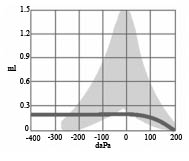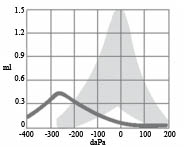Tympanometry tests the status of the middle ear, including the mobility of the eardrum (tympanic membrane), middle ear pressure, and ear canal volume. It is obtained by placing a probe in the patient’s ear to obtain a hermetic seal. In a single component tympanogram, a continuous 226 Hz low frequency tone is delivered into the ear canal with air pressures varying from +200 to -400 daPa. The resulting change in admittance (static compliance) is measured and used to assess the mobility of the eardrum. Static compliance refers to the ease of flow of acoustic energy through the middle ear. A higher frequency probe tone of 1000 Hz is used in infants less than 6 months of age because infants have different resonance characteristics in their middle ears and using higher frequency probe tones also
minimizes any effects of ear canal wall movement. It should be noted that there are no normative values for ear canal volume and pressure in 1000 Hz tympanogram readings. These results are generally considered to be normal if there is a clear peak and abnormal if there is no discernable peak.
There is increasing discussion in the literature about the use of wideband tympanometry testing as a diagnostic tool, however it is still under development and not yet ready for clinical use.
Tympanograms are traditionally evaluated based on their quantitative pattern and shape. The database provides raw data that you may classify as you see fit. One method of classification of tympanogram types that is commonly referenced when using a 226 Hz probe tone is described here.
Type A tympanograms have an identifiable peak observed at or near atmospheric pressure and represent normal middle ear function. Eardrum mobility, middle ear pressure and ear canal volume are all within the normal range.
Type B tympanograms are a flat line. Such tympanograms are often consistent with fluid or infection in the middle ear if they have an ear canal volume reading within normal limits, but can also be indicative of a perforation in the eardrum (including the presence of pressure equalizing tubes) if there is a larger ear canal volume reading.
Type C tympanograms also have a distinct peak, but are shifted negatively on the graph, suggesting the eardrum is moving but may be retracted due to pressure. Negative pressure within the middle ear is often caused by compromised eustachian tube function or sinus congestion. Variations in middle ear pressure can be a contributing factor to hearing loss.
Tympanometry measures should not be interpreted in isolation. Tympanometry is part of a complete test battery and results from other audiological tests should be considered in conjunction with these results.



